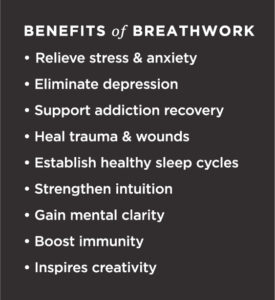When you hear the word “breathwork,” what comes to mind? For many people, breathwork is a new and mysterious concept. In this article, we will explore what breathwork is, how it works, who can benefit from it, and why you might consider trying it. We’ll also provide some resources for further exploration if you’re interested in learning more.
Contents
Understanding Breathwork

Breathwork is any type of therapy that uses breathing exercises to improve physical, mental, and emotional health. Breathwork can be used to treat a wide variety of conditions, including anxiety, depression, chronic pain, stress, and addiction. There are many different types of breathwork, each with its own unique benefits.
Theory Behind Breathwork
The theory behind breathwork is that the way we breathe can impact our physical, mental, and emotional health. When we breathe deeply and slowly, it can help to reduce stress and promote relaxation. Breathwork can also be used to improve our focus and concentration, as well as to increase energy levels.
Types of Breathwork
There are many different types of breathwork, each with its own unique approach. Some of the most common types of breathwork include:
- Pranayama is a type of yoga breathing exercises
- Qigong is a form of Chinese energy work that uses specific breathing techniques
- Rebirthing, which involves deep inhalations and exhalations to release emotional blocks
- Somatic Experiencing, is a form of therapy that uses breathwork to help release trauma
- Holotropic Breathwork, is a type of breathwork that uses intense deep breathing to produce altered states of consciousness
Examples of Breathwork Exercises
Here are some examples of breathwork exercises you might try:
- Take a few deep breaths in and out through your nose.
- Breathe in deeply and hold your breath for a few seconds. Exhale slowly.
- Breath in through your nose and exhale through your mouth, making a whooshing sound.
- Breath in deeply and imagine that you are breathing in energy or light. Exhale and release all of your negative thoughts and feelings.
- Breath in deeply and hold your breath for a few seconds. Then, exhale and imagine that you are releasing all of your stress and anxiety.
Types of Breathwork Therapist
There are two types of breathwork therapists: certified breath workers and registered nurses.
- Certified breath workers have completed a training program and are licensed to provide breathwork therapy.
- Registered nurses have been trained in somatic experiencing, which is a form of breathwork therapy that can be helpful for those who have experienced trauma.
History, And Development
The history of breathwork can be traced back to ancient times. Breathwork has been used in many different cultures for thousands of years for healing and spiritual purposes.
In the Western world, breathwork began to gain popularity in the 1960s and 1970s as a part of the human potential movement. Since then, people use breathwork for a variety of purposes including stress relief, emotional healing, and physical healing.
Unfolding Breathwork Therapy

If you decide to try breathwork therapy, you can expect to spend around an hour in a session. The therapist will guide you through a series of breathing exercises.
How Does It Work
The way that breathwork works is still being studied. However, it is believed that by changing the way we breathe, we can change the way we feel.
Furthermore, there are many different theories about how breathwork can improve our health.
- Some believe that breathwork can help to release toxins from the body.
- Others believe that breathwork can help to balance the nervous system, improve circulation, and increase the oxygenation of the blood.
Who Can It Help
Breathwork therapy can help people of all ages and backgrounds. It can be especially helpful for those who are struggling with stress, anxiety, or trauma.
Techniques Used In Breathwork Therapy
The techniques that we use in breathwork therapy vary depending on the type of breathwork. However, common techniques include deep breathing, visualization, and meditation.
- Deep breathing is a central component of most breathwork techniques.
- Meditation is sometimes used in breathwork as well. This can help you to focus on your breath and let go of any thoughts or distractions.
- Visualization is often used in conjunction with deep breathing. For example, you might be asked to visualize yourself surrounded by light or healing energy.
Evaluating Breathwork Therapy
Before deciding to try breathwork therapy, it is important to evaluate the pros and cons.
Benefits of Breathwork Therapy

Some of the benefits of breathwork therapy include:
- stress relief
- emotional healing
- physical healing
- increased energy levels
- improved sleep
Limitations of Breathwork Therapy
However, breathwork therapy also has its limitations. Some of the potential drawbacks include:
- it can be dangerous if done incorrectly
- there is not a lot of scientific evidence to support the benefits
Why Consider It
If you are struggling with stress, anxiety, or trauma, breathwork therapy may be a good option for you. As breathwork therapy is a safe, non-invasive treatment that can have a profound impact on your mental and physical health.
Things To Keep In Mind
Some things to keep in mind when considering breathwork therapy:
Breathwork can be helpful for a variety of issues, such as anxiety, depression, addiction, and stress. However:
- Breathwork is a relatively new therapy and more research will determine its effectiveness.
- Be aware of the potential risks and benefits of breathwork therapy before making a decision.
NOTE: It is important to talk with your therapist about any concerns you have before starting breathwork therapy. As some people may find breathwork helpful while others may not.
Finding a Breathwork Therapist

If you have an interest in finding a breathwork therapist, there are a few things you need to know and also to keep in mind.
How To Find One
The best way to find a breathwork therapist is to:
- Ask for recommendations from your doctor or mental health provider.
- Search online for breathwork therapists in your area.
What To Look Out For
When looking for a breathwork therapist, there are a few things to watch out for.
- First, it is important to find a therapist who has experience and certification in breathwork therapy.
- Second, you should ask the therapist about their approach to breathwork therapy and make sure that it is a good fit for you.
- Third, you should ask the therapist about their fees and make sure that you can afford the sessions.
Red Flags To Avoid
There are also a few red flags to watch out for when looking for a breathwork therapist.
- First, be sure to avoid therapists who promise instant cures or claim to have all the answers.
- Second, avoid therapists who are pushy or aggressive.
- Third, be wary of any therapist who asks you to sign a contract or pay for a series of sessions in advance.
Breathwork Therapist Vs. Pulmonologist
It is important to note that breathwork therapists are not the same as pulmonologists look. Pulmonologists are medical doctors who specialize in the treatment of respiratory conditions. While pulmonologists can provide helpful information about breathwork, they cannot provide breathwork therapy.
Pursuing Training In Breathwork Therapy
If you are interested in pursuing training in breathwork therapy, there are a few things to keep in mind.
- First, it is important to make sure that the program is accredited by a reputable organization.
- Second, you should make sure that the program offers hands-on experience and includes a practicum or internship component.
- Third, you should ask about the program’s faculty and make sure that they are experienced in breathwork therapy.
- Forth, it is important to make sure that you are physically and mentally prepared for the training.
- Finally, you should be prepared to commit to the training and practice breathwork regularly.
NOTE: We invite you to list yourself on Therapy Mantra’s Breathwork Therapist Directory.
Hearing From Experts
If you are still not sure about whether or not to try breathwork therapy, consider hearing from experts in the field. Below we are quoting two of the following:
“Breathwork is a powerful tool that can help people of all ages and backgrounds.
It is safe, non-invasive, and can have a profound impact on your mental and physical health.”
-Dr. Rachel Carlton Abrams, MD
“Breathwork is a powerful way to access the subconscious mind.
It can be used to release trauma, heal emotional wounds, and improve mental and physical health.”
-Dr. Joe Dispenza, DC
Case Study

Mrs. K is a 38-year-old woman who comes to therapy complaining of feeling “stuck” in her life. She reports that she has been feeling this way for the past year since she was laid off from her job.
Mrs. K says that she has been spending most of her time at home, taking care of her children and doing household chores.
She reports that she has not been able to find another job and her husband has been working long hours to make ends meet. Mrs. K says that she feels like she is just going through the motions of life and does not feel like she is living.
Mrs. K is interested in exploring breathwork as a way to help her feel more connected to her life. After discussing the basics of breathwork with Mrs. K, she decides to give it a try.
Breathwork Practice
Mrs. K begins by lying down in a comfortable position and closing her eyes. She is instructed to focus on her breath and allow herself to breathe deeply and slowly. As she breathes, she imagines her breath going all the way down to her belly. She continues to focus on her breath and allows her mind to wander.
After a few minutes, Mrs. K begins to feel more relaxed and her mind becomes quiet. She notices that she is no longer thinking about her job or her family. Instead, she is focused on the present moment and her breath. Mrs. K continues to breathe deeply and slowly for a few more minutes before opening her eyes and sitting up.
After effect
Mrs. K reports that she felt very relaxed after the breathwork exercise and that it was helpful for her to focus on something other than her stressors. She says that she would like to try breathwork again in the future.
Takeaway
Breathwork can be a helpful tool for people who are struggling with stress and anxiety. It can help them to focus on the present moment and feel more relaxed. If you are interested in trying breathwork, please speak with a qualified therapist to ensure that it is right for you.
Resources
If you have an interest in learning more about breathwork therapy, there are a few resources that you can consult.
- Association for Applied Psychophysiology and Biofeedback (AAPB): It is a good place to start. The website has a directory of certified breathwork therapists, as well as information about the different types of breathwork therapy.
- National Center for Complementary and Integrative Health (NCCIH): This website provides information about the different types of breathwork, as well as studies on the benefits and limitations of breathwork therapy.
Conclusion
Breathwork therapy is a safe, non-invasive treatment that can have a profound impact on your mental and physical health. It is a promising practice that can help people heal from trauma and stress. If you are considering breathwork, it is important to do your research and find a qualified therapist.
A Word From Therapy Mantra
Your mental health — Your psychological, emotional, and social well-being — has an impact on every aspect of your life. Positive mental health essentially allows you to effectively deal with life’s everyday challenges.
At TherapyMantra, we have a team of therapists who provide affordable online therapy to assist you with issues such as depression, anxiety, stress, workplace Issues, addiction, relationship, OCD, LGBTQ, and PTSD. You can book a free therapy or download our free Android or iOS app.


